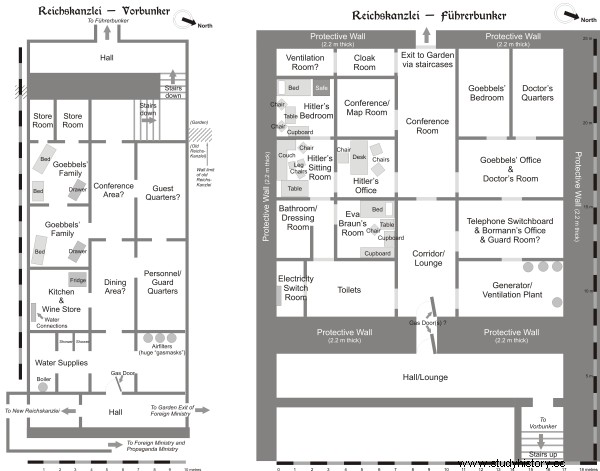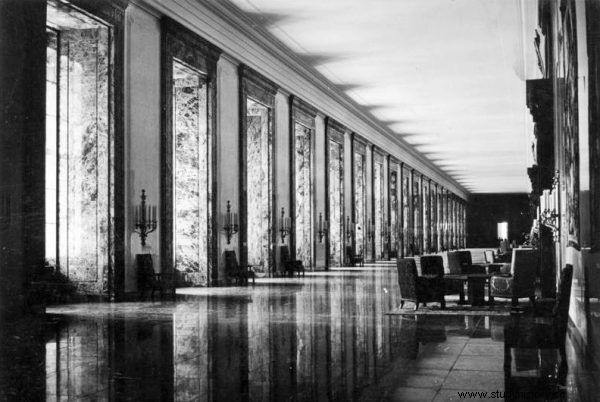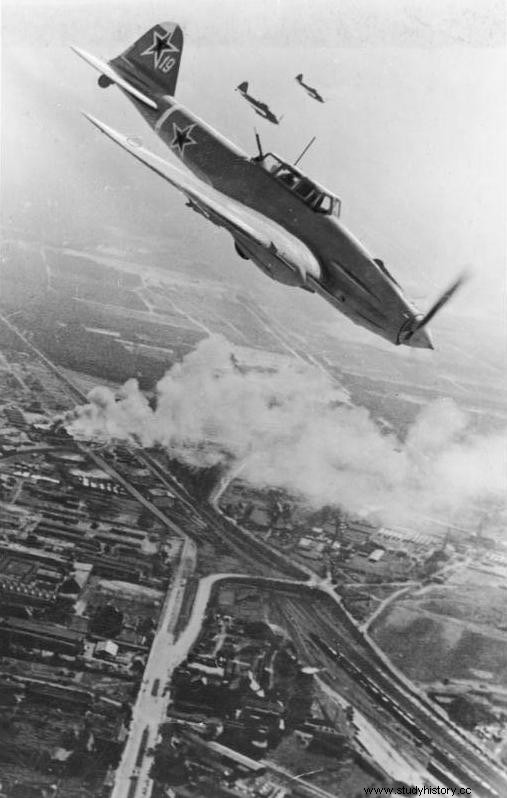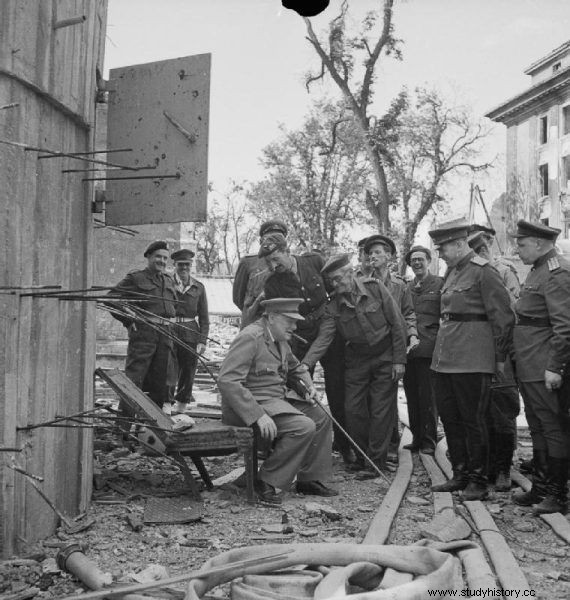The shelter under the Reich Chancellery witnessed extraordinary events. Hitler's entourage lived in a world of illusion and intoxication. In the face of imminent defeat, they released all the brakes. What did this mean for ordinary people who had the misfortune to come so close to a chief?
The Führerbunker was the last headquarters of Adolf Hitler. The leader of the Third Reich moved to her in mid-March 1945. He was completely independent from Berlin . It had its own water source, an air filter system (Hitler feared the Russians would use war gases) and enormous food resources. They were to be enough for the crew and the entire staff of the Reich Chancellery.
The underground shelter consisted of two parts. In the front bunker there were rooms of the minister of propaganda's family and staff, a kitchen and a wine cellar . In the proper bunker, apart from Hitler's apartment and Ewa Braun's room, a guardhouse, power generators and a small telephone center were located. Its operation left much to be desired. To find out about the situation in the city, the city's normal telephone network was used.

The front bunker (left) and the bunker proper under the Reich Chancellery (Fig. Dennis Nilsson, CC BY 3.0).
The last of the faithful
In addition to Hitler, Ewa Braun, the Goebbels family and Bormann, the bunker was inhabited by:Hitler's dietitian Constanze Manziarly, telephonist Rochus Misch, mechanic Hentschel, chief's guard, and until April 22, also his doctor, Theo Morell.
The rest of the bunker staff and Hitler's personal entourage - his secretaries, representatives of all types of armed forces and the commander of the defense of the government district, General Wilhelm Mohnke - lived in the rooms under the Reich Chancellery.

The article was based, inter alia, on on the book by Nicholas Best entitled "5 days that shook the world."
A field hospital was also set up in the basement of the Chancellery, in which 20 girls from the Union of German Girls (BDM) were found. Fearing rapes by Soviet soldiers, they fled their homes and ended up in the center of Berlin, where they became nurses.
Together, both bunkers had over 300 square meters of space . Not much for the dwelling of a man who until recently ruled all of Europe.

Admiral Karl Dönitz and Adolf Hitler in the bunker near the Reich Chancellery, 1945 (photo Bundesarchiv, Bild 183-V00538-3, CC-BY-SA 3.0).
The Exodus of the Dawn
On April 20, 1945, the last birthday of the leader of the Third Reich was celebrated . Ailing, barely hiding the trembling of his hands, Hitler rewarded young members of the Hitler Youth who fought against Soviet tanks on the outskirts of Berlin. Then he welcomed individual members of the government who came to him with greetings.
After this event, a kind of exodus of Nazi bonzons began who wanted to avoid being locked in a besieged city. All who escaped tried to get west. American slavery seemed much safer than falling into the hands of the hated Bolsheviks.
In the underground castle of illusions, where it was still under the illusion that the war could be won by a miraculous maneuver, only Goebbels and his family and Martin Bormann remained with the Führer.
The civilians and military who stayed with Hitler until the end had to cope with the harsh atmosphere in the bunker and the fear not only of the approaching Red Army. Any disobedience could still be fatal.
This article has more than one page. Please select another one below to continue reading.Attention! You are not on the first page of the article. If you want to read from the beginning click here.
As Nicholas Best writes in the book "Five days that shook the world", Only Ewa Braun approached the situation with stoic calm . During her last meeting with the Minister of Economy, Albert Speer, she seemed not to notice the gravity of the situation. She offered him: How about a goodbye bottle of champagne? And some jam? You probably haven't had anything in your mouth for a long time .

The Chancellery of the Third Reich was a truly impressive building. But at the turn of April and May 1945 it was only safe in its basement (photo:Hoffmann, from the Bundesarchiv collection, Bild 183-K1216-501, CC-BY-SA 3.0).
Another world of the leader
While the Soviet troops were tightening the encirclement around Berlin, Adolf Hitler continued to live up to his dreams of an eventual victory. Staring at the painting of Frederick the Great, the only decoration of his bunker, led the non-existent armies during the war councils , demanding an immediate attack to ease the burden on the besieged capital.
The illusion of the approaching Wenck's 9th Army was the only hope for Hitler, who was already losing his mind. Visually impaired, suffering from Parkinson's disease Führer lost all contact with reality . The meetings with the generals turned into a tirade of screams and complaints about betrayal by the higher commanders.
The leader of the Third Reich also repeated one sentence like a mantra:"not a step back". The famous tirade scene from the movie "The Fall" did take place . After the information about the collapse of Steiner offensive, Hitler managed to utter the famous sentence:"Es ist alles verloren" - "Everything is lost". This took place on April 22nd.
Ordinary Berlin Cavemen Day
Since moving to Berlin in January 1945, Hitler was falling more and more into a "cave" way of life. He rarely left the shelter, usually for a maximum of an hour each day, when he would take his she-wolf for walks. The sunlight dazzled his eyes and left the bunker for the last time on April 23 . The rest of the crew, if possible, left the underground "for a cigarette" - smoking in the presence of the chief was forbidden.

The garden in the courtyard of the Reich Chancellery was destroyed in 1947. It was here that Hitelr took his last breath of fresh air (photo Bundesarchiv, Bild 183-V04744, CC-BY-SA 3.0).
Usually a chief's day would start around ten or eleven o'clock in the morning when Hitler got up. He spent a maximum of four hours sleeping. Of course, if sleeping was possible, because in the last few days the bang of explosions was already reaching the interior of the bunker.
Unless Hitler ate alone, usually only women sat at his table. They were his secretaries, Ewa Braun, or his private dietitian. The Führer made an exception only for General von Greim, who flew with Hanna Reitsch to besieged Berlin.
Meals were the subject of complaints from everyone who ate with Hitler . Vegetarian, meager food did not arouse the enthusiasm of Hitler's comrades, who were used to meat dishes.

The Il-2 plane dives over Berlin, April 1945. Perhaps Hitler heard the explosions of the bombs he dropped (photo Bundesarchiv, Bild 183-R85077, CC-BY-SA 3.0).
Dance of death
In the face of the inevitable defeat, many of the bunker's inhabitants tried to alleviate their worries by indulging in fun and drunkenness, to throw away the fear of the unknown at least for a moment.
As Baroness Irmingard von Varo, who recently lived in the bunker, recalled, sorrows were drowned in liters of alcohol which was helped by the wine cellar in the bunker. At the same time, the music from gramophone records was entertained.
This article has more than one page. Please select another one below to continue reading.Attention! You are not on the first page of the article. If you want to read from the beginning click here.
All this to put aside the prospect of a ghostly future. However, alcohol also had an effect on the atmosphere, as drunk party officials accused each other to bring them to the situation in which they found themselves.

Adolf Hitler and Eva Braun, June 1942 (photo Bundesarchiv, B 145 Bild-F051673-0059, CC-BY-SA).
Wedding and death
One of the last acts of the drama began at midnight on April 29. In the presence of Goebbels and Bormann, Hitler married Ewa Braun. The wedding reception was held against the backdrop of Soviet artillery fire. The groom didn't spend much time having fun - he was busy dictating his will to the secretary of Traudl Junge.
On the night of April 29-30, when the end of the Thousand-Year Reich was approaching, Dr. Schenck and Dr. Hasse arrived in the bunker, who were to give Hitler advice on how to end his life. Schenck recalled that while they were present, jazz music could be heard and the sounds of a lavishly drenched party taking place in the soldiers' canteen above.

The article was based, inter alia, on on the book by Nicholas Best entitled "5 days that shook the world."
The last ball was so intense that even the guards disappeared from the bunker. Nobody wanted to miss the last opportunity to play before their expected death. All sorts of brakes were released in her face. The inhabitants of the bunker indulged in casual sex , there were also quick weddings.
The most interesting orgies took place in the dentist's office in the Reich Chancellery. Nicholas Best quotes in "Five days that shook the world" Dr. Schenck's account:
More discreet couples used the dentist's chair in Dr. Kunz's office upstairs, in the Chancellery building. This armchair seemed to be a particular erotic attraction. The rogue women enjoyed being restrained and having sex in a variety of fancy positions.

The situation on the fronts of World War II in Europe on May 1, 1945. No wonder that the inhabitants of Hitler's bunker were getting nervous (picture by the U.S. Army, public domain).
In the morning, Hitler's personal driver, Erich Kempka, went in search of 200 liters of fuel needed to burn the corpse. Meanwhile, the chief was eating his last meal with the secretaries:spaghetti with tomato sauce. Around 15.30 the Führer and his wife committed suicide. After a few hours, there was not much left of their incinerated bodies.
On the evening of May 1, the new Reich Chancellor, Joseph Goebbels, committed suicide with his wife after killing six of his children, the youngest of whom was four years old.

The Goebbels family on January 1, 1944 (photo:Bundesarchiv, Bild 146-1978-086-03 / CC-BY-SA 3.0).
End of illusion
Most of those who were still in the bunker decided to escape. Food and drink were obtained by opening warehouses. Few chose to stay until the end. Gen. Burgdorf was so drunk he couldn't stand. General Krebs, who was negotiating capitulation with the Russians, was too agitated to save lives.
Most of those who did not want to flee decided to commit suicide. Only mechanic Hentschel, who delivered water to the wounded from the hospital near the Chancellery, survived. The first to reach the bunker were Russian nurses, who carefully collected the entire contents of Ewa Hitler's wardrobes.

Winston Churchill sits down on a damaged chair from Hitler's bunker (photo:W.T. Lockeyear, E.G. Malindine, No 5 Army Film &Photographic Unit; from the Imperial War Museums collection, public domain).
Five kilometers from the Reichstag, in an abandoned brewery, where some of those escaping from the bunker had arrived, there was a group orgy, heavily sprinkled with alcohol . In this way, the fugitives released their stress before falling into captivity. Many women committed suicide for fear of being raped at the hands of drunken Red Army soldiers. The Third Reich, which was to last a thousand years, collapsed after only twelve years.
Bibliography:
- Uwe Bahnsen, James O'Donell, Last days in Hitler's bunker , Warsaw 2005.
- Nicholas Best, Five Days That Shook the World , Krakow 2016.
- Traudl Junge, With Hitler to the end , Warsaw 2003.
- Robert M. Jurga, Fortifications of the Third Reich in spatial drawings , Czerwonak 2013.
- "After the Battle. Special Edition ”, No. 61, London 1988.
